7. The Untouchables (1987)
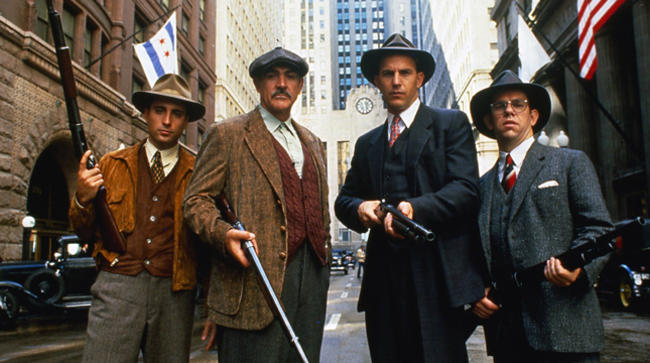
This heat packin’ Prohibition-era epic The Untouchables represents a fateful package and presentation of numerous fortuitous circumstances for De Palma. The stylish innovator was in need of a hit after his black comedy Wise Guys (1986) failed to meet expectations, and so, with David Mamet’s script revamping the Eliot Ness vs. Al Capone in Chicago in the 1920s, there seemed a potentially promising project.
It also enabled De Palma to re-team with Robert De Niro, whose career he helped boost with those previously discussed early comedies, Greetings (1968), The Wedding Party (1969), and Hi, Mom! (1970).
Also adding bite to the cast was then unknown Kevin Costner as Ness, and Sean Connery making a late career comeback that would covet him an Oscar win in the process, for his supporting role as Irish-American beat cop Jimmy Malone.
A violent, often vulgar, over-the-top crime spectacle, it’s easy to draw a line from De Palma’s other big gangland epic Scarface, to this, as far as shots fired and stylish flourishes are concerned.
Emblematic of all his work, The Untouchables encompasses his trademark furbelows; the split-diopters, slow motion, split screens, tracking point-of-view shots, and intricate action sequences. The tommy-gun toting shootout at Union Station, which plays out with a ferocious intensity and even boldly dares to references Sergei Eisenstein’s epic Battleship Potemkin, specifically the massacre on the Odessa steps, is a show-stopper.
Gangland Chicago is romanticized and bullet-ridden by the film’s end, some historical liberties aside, it all still amazingly amounts to one of the best cops and gangster movies around, period.
6. Scarface (1983)
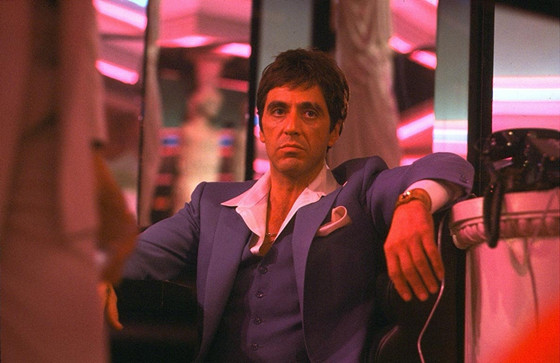
“Say hello to my little friend!”
This hugely influential epic crime film, also a cultural touchstone––just look at the impact the film has had on hip hop, as well as gamer culture––Scarface is an excessively violent and famously foul-mouthed (it drops the f-bomb some 226 times!) cautionary tale of how absolute power corrupts absolutely.
With sensational Oliver Stone script that reimagines the 1932 Howard Hawks classic, moving the Chicago setting into 1980s Miami where Cuban refugee Tony Montana (Al Pacino) stakes a bloody claim into the drug trade.
Viciously murdering anyone who stands in his way amidst mountains of cocaine as he antagonizes police and Colombian drug cartels alike, his drug-fueled paranoia only briefly subsiding so he can do a little disco with one Elvira Hancock (Michelle Pfeiffer), this is one decadent, indulgent, ultra-violent, and stylishly gauche affair.
Oh Tony, “The World is Yours” could’ve been your mantra instead of your death knell. Not to be missed.
5. Phantom of the Paradise (1974)
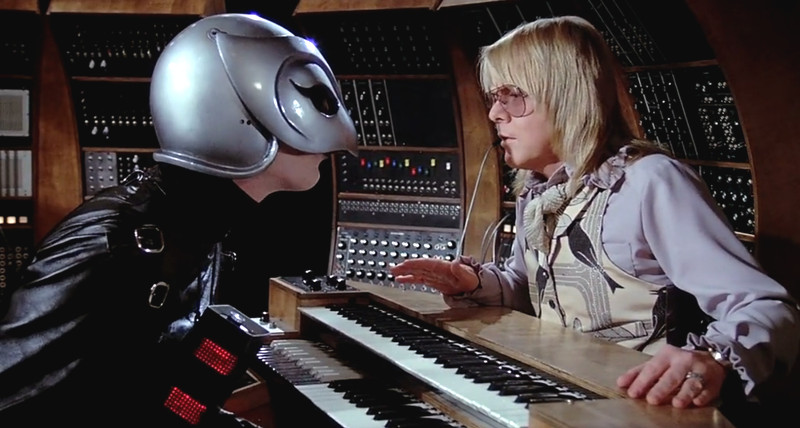
“Brian De Palma has an original comic temperament; he’s drawn to rabid visual exaggeration and to sophisticated slapstick comedy,” wrote Pauline Kael, adding “[Phantom of the Paradise] is a one-of-a-kind entertainment, with a kinetic, breakneck wit.”
In 1974 De Palma made the ultimate midnight movie, a campy, way over-the-top horror musical that beat the Rocky Horror Picture Show to the punch by a solid year and a half. As a playful piss take on popular music, Phantom of the Paradise nails a lot of the tropes of the era, sending up the Beach Boys, Glam Rock, and a Phil Spector-like impresario named Swan, amongst them.
Paul Williams is wonderful in the role of Swan, and his superb soundtrack is still gobsmackingly brilliant some forty years on. William Finley in the titular role as the cursed Phantom is also a terrible treat, and the fervent cult that has embraced the film have elevated both Finley and Williams to the stature of icons.
The much ballyhooed New Hollywood of the 1970s sired many enterprising cinematic curiosities but few as exhilarating, outlandish and impressively stylish as Phantom of the Paradise. For all its crackbrained exuberance and frequently hallucinatory tenor, this musical version of Faust is a feast for the senses; silly, exaggerated, and overblown, this is a film that, by midnight movie standards and beyond, is some kind of carefully constructed masterpiece.
4. Dressed to Kill (1980)
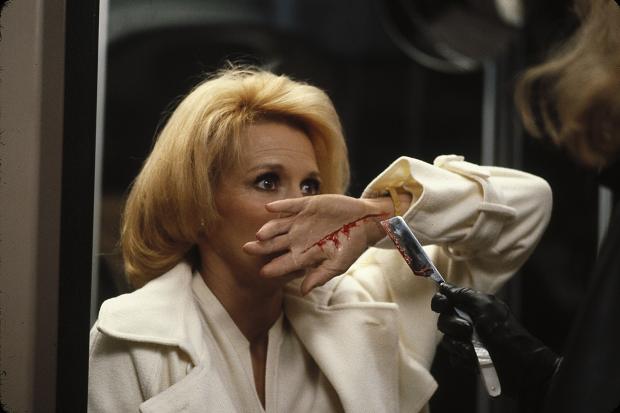
Dressed to Kill is as sharp and explicit as it gets and still manages to keep its tongue firmly planted in its cheek all the while. From its fetishized slo-mo opening with a soft-core flourish as housewife Kate Miller (Angie Dickinson, excellent) has a sudsy fantasy in the shower to her brutal Psycho-esque butchering––complete with vivid violin score––in an elevator before the first act has finished, this is a masterfully made symphony of sensuality and terror.
Eye witness Liz Blake (Nancy Allen), who doubles as an unreliable escort, Kate’s intelligent teenage son Peter (Keith Gordon), and Kate’s eccentric psychiatrist Dr. Robert Elliott (Michael Caine) may hold the secret to Kate’s death. But who do we trust amongst these three, if any?
Dressed to Kill dips into dark fantasy on several occasions, combining sensuality and danger at every turn, smashing taboos––gender dysphoria is portrayed with acrimony––and it’s all done with such wild and varying techniques and flourish that it will leave you gasping for air. A thrill.
3. Body Double (1984)
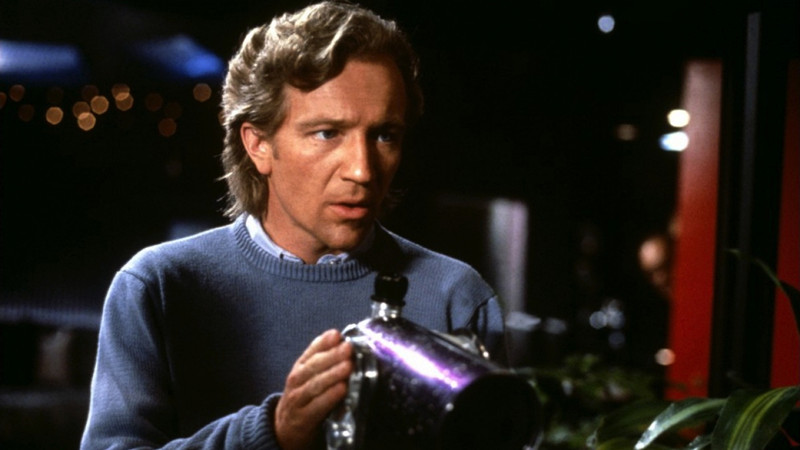
De Palma gleefully toys with his favorite Hitchcockian themes of obsession and voyeurism in this erotically-charged overture, the subversive, sleek, and deliberately trashy Body Double.
Jake Scully (Craig Wasson) is a B-actor of bad horror films now fallen on hard times. His actor pal Sam Bouchard (Gregg Henry) takes pity on him and hooks him up with a house sitting gig at an ultra-modern home in the Hollywood Hills. Before you know it Jake is spying on his sexy neighbor who does salacious stripteases like clockwork each night, in front of her bedroom window, curtains wide open for easy peeping.
Using every stylish flourish in his expert attaché, the thriller that unfolds is bounteous with twists and turns, astonishing reveals, fearsome flashbacks, rakish innuendo, and mounting tensions. Body Double keeps piling on the peril and the panache and then unleashes a gobsmacking turn late in the film from Melanie Griffith as porn star Holly Body. Holly is somehow stitched into the labyrinthine yet airtight plot that keeps going too far.
As sleazy objet d’art and enjoyable escapist pleasure, Body Double is De Palma’s most indulgent delight. It just doesn’t get any sleeker, sexier, or risqué as this subversive chef d’oeuvre.
2. Carrie (1976)

This watershed fright flick from De Palma is prestige horror writ large. Teen angst, religious zealotry, melodrama, and household Gothic coalesce with formalist flare in this supernatural white-knuckler which is also the first and arguably best adaptation of a Stephen King novel.
Wallflower Carrie White (Sissy Spacek) is a religious fanatic’s teenage daughter who starts to display paranormal powers just as her confusion over puberty culminates in unbearable and embarrassing ordeals via the social strata of high school.
The cruelty Carrie suffers via her peers compounds with that which she suffers at home from her abusive born-again mother, Margaret (Piper Laurie). This terrible abuse is a trigger for Carrie’s telekinesis, and can vengeance be far behind? The prom scene is a tour de force of terror and tragedy as De Palma pulls no punches in one of the most riveting climaxes ever captured on film.
This operatic, tragic, and provocative teen revenge-fantasy is a masterclass in narrative panache with a thunderous payoff and an eerie delicacy. She may not be the perfect prom date but Carrie makes for a teasing and sensational night out. Essential viewing.
1. Blow Out (1981)
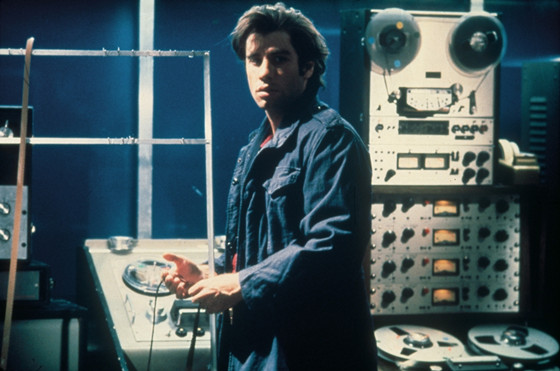
De Palma’s 1981 thriller Blow Out is his pièce de résistance, largely ignored on its initial release, though critically lauded, it’s the work of a master craftsman at the peak of his considerable powers.
Inspired in equal parts by Antonioni’s arthouse hit from 1966, Blow Up, and Coppola’s anxiety-addled 1974 thriller The Conversation, De Palma’s mystery involves a movie soundman, superbly played by John Travolta, that may or may not have recorded a murder while on assignment capturing audio for an exploitation slasher film.
Without giving anything away, the plot widens as disparate characters surface –– Nancy Allen astounds as a call girl in peril, and a savage serial killer springs from the shadows, as does evidence of a conspiracy. The risks and rewards escalate, and all the while ambiguity and uncertainty reigns.
Pauline Kael wrote: “Seeing Blow Out is like experiencing the body of De Palma’s work and seeing it in a new way. Genre techniques are circuitry; in going beyond genre, De Palma is taking some terrifying first steps. He is investing his work with a different kind of meaning. His relation to the terror in Carrie or Dressed to Kill could be gleeful because it was pop and he could ride it out; now he’s in it.”
One of the many pleasures De Palma offers here, and it’s true of all his best work, is that his daring and audacious style is present and on proud display. Split-screen ruses, wild tracking shots, crazy point-of-view progressions, startling use of split-focus diopters, intense and emotional slow motion sequences, gallows humor, red herrings, Hitchcockian flourish and reveals; it all amounts to a dizzying, swelling Tell-Tale Heart climax.
So severe and flat-out horrific is the finish that Quentin Tarantino famously told De Palma that it was easily “one of the most heartbreaking shots in the history of cinema.”
Brian De Palma is my favorite director, nobody makes movies as rowdy, as playful, and as seemingly out-of-control as him, and this is his showpiece. Blow Out is chilling entertainment at its most delirious, breathtaking, and bittersweet.
“De Palma deserves more honor as a director. Consider these titles: Sisters, Blow Out, The Fury, Dressed to Kill, Carrie, Scarface, Wise Guys, Casualties of War, Carlito’s Way, Mission: Impossible. Yes, there are a few failures along the way (Snake Eyes, Mission to Mars, The Bonfire of the Vanities), but look at the range here, and reflect that these movies contain treasure for those who admire the craft as well as the story, who sense the glee with which De Palma manipulates images and characters for the simple joy of being good at it. It’s not just that he sometimes works in the style of Hitchcock, but that he has the nerve to.”
– Roger Ebert
Author Bio: Shane Scott-Travis is a film critic, screenwriter, comic book author/illustrator and cineaste. Currently residing in Vancouver, Canada, Shane can often be found at the cinema, the dog park, or off in a corner someplace, paraphrasing Groucho Marx. Follow Shane on Twitter @ShaneScottravis.